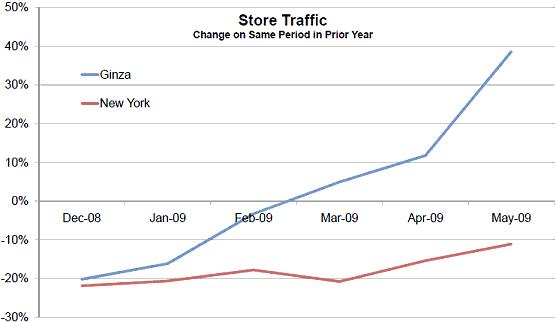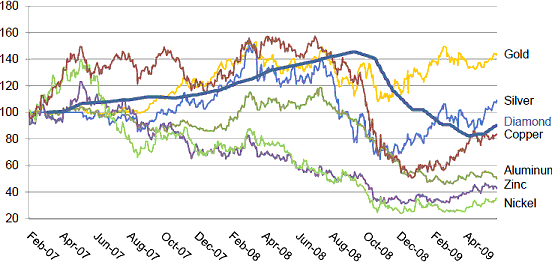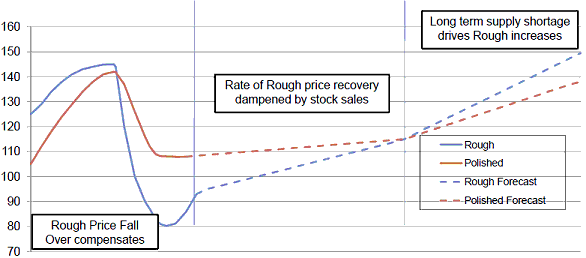IDEX Online Research: Harry Winston U.S. Retail Sales Show Smaller Decline in Q1
July 02, 09
Harry’s Winston’s U.S. retail store sales decline diminished dramatically in the first fiscal quarter ended April 2009. After plummeting by 60 percent in the fourth quarter of 2008, sales in the first quarter of 2009 fell by only 25 percent in the eight U.S. salons.
However, total Harry Winston global retail sales – including the U.S., Europe and Asia – were down by 30 percent in the first quarter of 2009, a worse trend than the 21 percent decline reported in the fourth quarter of 2008. Sales in the two remaining Europe stores collapsed in the first quarter – down from a 77 percent increase in the fourth quarter to a 39 percent decrease in the three months ended April 2009, in part due to the closing of the Geneva store in the third quarter of 2008. Sales in Asia (eight Harry Winston salons) fell by 24 percent in the first quarter, somewhat worse than the 16 percent drop in the fourth quarter of 2008.
The table below summarizes financial data for Harry Winston’s retail division.
 Source: Harry Winston Diamond Corporation |
First Quarter Highlights
- Unlike most other suppliers who are reported absolutely dismal sales results, Harry Winston’s total corporate revenues were down 30 percent in the quarter ended April 2009, with each of its operating divisions – mining and retail – down roughly 30 percent. We would have expected its mining division to show a much more pronounced decline. Further, we are impressed that its retail division was down by only 30 percent; most very high-end jewelers are reporting worse results.
Total revenues for Harry Winston Diamond Corporation – mining and retail – were $109.6 million in the first quarter, with mining revenues of almost $57.7 million and retail revenues of just under $52.0 million.
- Historically, Harry Winston Diamond Corporation management has not provided much detail about its retail operations, and the first quarter of 2009 was no exception. Instead of the usual conference call (which is typically focused on the mining operation), management spoke briefly about its retailing division during the company’s annual meeting in early June. The highlights of that discussion were as follows:
- Harry Winston retail consisted of six stores when it was acquired by Aber Diamond (now Harry Winston Diamond) five years ago (June 2004); today it consists of 18 stores. One store was opened in Costa Mesa, California in August 2008, while its store in Geneva closed in the third quarter (but is still listed in the company’s recently issued 2009 annual report). One new store is slated to open this year – in Singapore – which management said will be the 19th store. This store is scheduled to open in the second quarter.
- Harry Winston management noted that the retail sales decline of 30 percent in the first quarter was due in part to tough comparisons against last year’s +27 percent sales increase which came from particularly strong demand in Asia and Russia in early 2008. In the first quarter of 2008, sales in Harry Winston’s Europe salons were up 42 percent (most Russian sales are in this sales comparison) while sales in the Asian salons were up by a dramatic 52 percent. Clearly, these strong gains made sales comparisons tough this year, given the current recessionary economic climate.
- Retail store traffic in the Harry Winston salons (their word for “stores”) is “improving,” according to management. Most of the improvement apparently has come in the non-U.S. division. During its presentation to shareholders, management presented the following slide which illustrates store traffic in its flagship New York store versus its flagship store in Japan located in the Ginza district.
| Flagship Store Traffic
|
- Harry Winston branded watches and jewelry can now be found in stores operated by third parties in the Middle East and Russia. Management noted that it felt that third parties could do a better job of operating stores in those locations versus owning and operating its own stores.
- Management noted that Harry Winston had developed a new advertising campaign; slides illustrating this campaign were shown to shareholders.
- Harry Winston management presented a graph to illustrate its retail customer base. Data from the graph is shown below (percentage shown is percent of total customer base).
Harry Winston retail customer base by country of residence: - Japan 31 percent
- USA 25 percent
- Asia 14 percent
- China 11 percent
- Other Asia 3 percent
- Europe 22 percent
- Russia 16 percent
- Other Europe 6 percent
- Middle East 7 percent
- Canada, Mexico, South America 1 percent
- Harry Winston Diamond Chairman Bob Gannicott assured shareholders that the future was brighter: “The world of diamonds is fundamentally under-supplied,” he told the annual meeting audience.
- The retail division posted a gross margin of 48.6 percent this year, up from last year’s 45.1 percent. Last year’s gross margin was negatively affected by three factors: 1) an increased contribution of high-dollar value transactions which carry a lower-than-average gross margin; 2) an increase in costs related to precious metals and gemstones; and, 3) an increase in research and development costs to support the watch business. Excluding the impact of sales of Harry Winston pre-acquisition inventory (which is now five years old and should have been melted, sold, or liquidated long ago), the company’s gross margin would have been 49.6 percent in the first quarter versus 47.3 percent last year.
- Due to lack of sales leverage and other relatively fixed costs that cannot be eliminated easily, the company’s operating cost ratio rose to 58.2 percent of sales in this year’s first quarter versus 48.3 percent last year in the quarter ended April.
Shareholder Meeting Highlights
While there were only a few questions from Harry Winston shareholders, they were questions that had substance. Here’s a sampling:
- One shareholder asked about the possibility of promoting Canadian-sourced diamonds to consumers, ostensibly as politically correct diamonds. Gannicott noted that there were some early efforts by Canada to market Canadian stones, but that they were unsuccessful. He further noted that two suppliers in Yellowknife sell Canadian diamonds which are marketed as “sourced in Canada.” The results are of this marketing strategy are mixed: 1) those diamonds seem to move faster in the U.S. market; but, 2) they do not command a premium price. Further, he noted that Canada does not produce a full quality range of diamonds, especially related to color and clarity. Thus, it would not be possible for a retailer to claim that he sells “only Canadian diamonds.” Finally, once a diamond leaves a mine, it is often difficult to determine its origin; it is far too easy for diamonds from Canada to become intermingled with diamonds from other countries.
- One shareholder asked about the possibility of opening a Harry Winston salon in Toronto, the corporate headquarters of Harry Winston Diamond Corporation. Gannicott said that Toronto is “not in the future plans for a Harry Winston” store.
- During management’s presentation to shareholders, it flashed one slide on the screen that noted Harry Winston’s response (in its retail division) to protect profits during the global recession:
- Restructured the organization
- Reduced capital expenditures (one salon opening in 2009 – Singapore)
- Reduction in inventory purchasing
- Cost reduction measures
- Travel restrictions
- Hiring freeze
- Layoffs
- Marketing spend reductions
- Regarding the rough diamond mining division, management presented two slides that showed mineral price performance of rough diamonds versus gold, copper, silver, aluminum, zinc and nickel. Management noted that rough diamond prices seem to follow copper prices more closely than other mineral prices; we think this is a case of accidental correlation. Rough diamond prices are for Harry Winston rough gemstones, and are shown as the solid dark blue line (the one that does not “shake”).
| Mineral Price Performance
|
- Harry Winston management also developed its own forecast for rough and polished diamond prices. Even though it did not define “medium term” (the middle part of the graph below) or “long term” (the right hand portion of the graph), it confirms Gannicott’s forecast that the world of diamonds is fundamentally under-supplied.
| Rough and Polished Diamonds Outlook
|
The graphs in this article were sourced from Harry Winston’s shareholder presentation, and they are subject to change.


